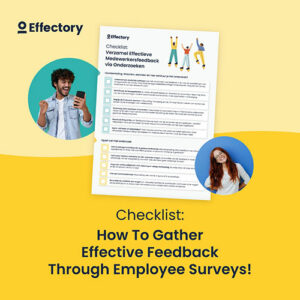The first step in this series on how to create engaging employee surveys tackles the preparation phase. Before you start focusing on the actual survey, consider the purpose and goal, relevant stakeholders and how to ensure anonymity.
Step #1: how to conduct an employee engagement survey

Launching a successful employee engagement survey requires a well-prepared strategy and careful consideration for the pre, during and post survey steps. Firstly, you need a clear idea of the aim of your survey. Secondly, it is important to decide on and involve stakeholders from the outset. Which survey method is most suitable for your organization? Will a pulse survey be better recieved than an annual engagement survey? How will you handle anonymous employee survey questions?
6 key criteria to find the right employee engagement survey provider
How to create an employee engagement survey? First, define the purpose!
An employee engagement survey should be designed to gain insights into perceptions of work motivation, team dynamics, leadership, organizational culture, resources and other topics pertinent to your organization. Perhaps innovation is lacking, or customer-centricity requires attention. Are your employees engaged? Are they suitably challenged? Make sure to define the employee engagement survey purpose!
Benefits of measuring employee engagement
Among other things, whether you opt for a quick and flexible pulse survey or a broader engagement survey, which in both case guarentee anonymous survey questions, you must determine whether you want to gain insight into job satisfaction, employee commitment, employee engagement, loyalty, motivation and customer orientation of your people.
The aim is to use the insigths gained to address issues before they escalate and to make targeted improvements where needed. Without a clear objective, your survey will have less impact and may not obtain the response rates you need.
Discover the value of employee engagement in human resource management
How to gather feedback from your employees
The definitive checklist for creating your employee engagement survey.
DownloadInvolvement of stakeholders
It’s important to generate full support for your survey across your organization. Too many survey reports go straight to the bottom drawer because the results are ultimately not valued, accepted or applied. To avoid this pitfall, it is essential to involve all relevant stakeholders not only in the launch phase, but also in the preparation phase. If you want your stakeholders to take action on the results, you’ll need to win them over in advance by including them in the decion-making process.
The stakeholders that should be involved in the survey from an early stage are:
- (Line) managers
- Other direct reports
- HR director and managers
- Executive board
- Internal communication department
- Works council (if applicable)
- Trade unions (if necessary)
It’s advisable to involve works council representatives from the outset, not only to adhere to rules and expectations but also because a works council can play an important role in embedding the survey in the organization. If you work at an international level, you’ll need to get regional managers involved as well.
The benefits of employee engagement
Which survey method is appropriate for your organization?
When thinking about how to conduct employee engagement survey, consider which survey method is appropriate for your organization. This is also the time to consider whether you should implement the survey and the associated follow-up yourself or engage an external agency.
There are three phases of the methodology to be considered:
- Distribution: How can you distribute the questionnaires in such fashion as to reach everyone with ease?
- Participation: What is the most appealing way for respondents to participate in the survey?
- Data collection: How do you ensure that you receive the maximum number of responses?
There are many methods for conducting surveys, but two methods are widely used depending on the type of organization: via an online questionnaire and/or via a written questionnaire. Choose the method that best suits your situation and that makes it easy for employees to complete the questionnaire. A good survey leads to a high response rate. You may find, for example, that pulse surveys are more appealing to your people than annual engagement surveys.
The best tips on how to improve employee engagement in your company
Whitepaper: 7 Tips for your employee survey
Download this whitepaper and receive 7 tips to think about before starting your next employee survey, as well as tricks to avoid common pitfalls.
DownloadAnonimous employee survey
As well as a high response, you also want reliable results. You want employees to feel free to give their honest opinion. Can you guarantee that they will be able to complete the questionnaire anonymously?
In the interests of anonymity, you should consider the following points:
- Ensure that employees can complete the questionnaire without feeling supervised
- Make sure that answers are received and stored on a secure platform and/or server
- Keep questions about personal characteristics to a minimum (avoid insofar possible questions on gender, educational level, years of service, etc.)
- Convert handwritten answers into standard (computer) fonts
- When reporting the results, keep data at group level insofar as possible
In addition to anonymous employee survey questions, prevent situations where employees can fill in the employee engagement questionnaire more than once. To avoid duplication and unreliable results, employees should only be able to give their opinion once. Therefore, be sure to work with unique login codes that can only be used once.
Employee Engagement
Increase employee engagement through action-oriented feedback. Using a single platform, you can collect reliable data, analyze the results, and share insights.
view employee survey solution
